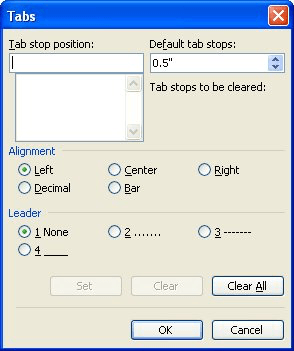Please Note: This article is written for users of the following Microsoft Word versions: 97, 2000, 2002, and 2003. If you are using a later version (Word 2007 or later), this tip may not work for you. For a version of this tip written specifically for later versions of Word, click here: Setting Decimal Tabs in a Table Using the Keyboard.
Written by Allen Wyatt (last updated July 28, 2018)
This tip applies to Word 97, 2000, 2002, and 2003
If you love using the keyboard, you may wonder if there is a way to set decimal tabs in a table using the keyboard. Unfortunately, there is no simple, fast keystroke to set the decimal tabs. The best way is to use the regular accelerator keys that Word uses. You would follow these steps:

Figure 1. The Tabs dialog box.
If you would rather not go through such an easy-to-remember process (grin), then you can also create a macro that will do the trick, and assign the macro to a shortcut key. The following is an example of a simple VBA macro that would do the job:
Sub SetDecimal()
Dim MyTab As String
MyTab = InputBox("Location (inches):", "Set Decimal Tab")
If Val(MyTab) > 0 Then
With Selection.ParagraphFormat.TabStops
.ClearAll
.Add Position:=InchesToPoints(Val(MyTab)), _
Alignment:=wdAlignTabDecimal, _
Leader:=wdTabLeaderSpaces
End With
End If
End Sub
This macro, which should be run after the cell or column is selected, clears all the existing tabs in the selection, and then prompts the user to enter a value for the new tab stop.
Note:
WordTips is your source for cost-effective Microsoft Word training. (Microsoft Word is the most popular word processing software in the world.) This tip (1912) applies to Microsoft Word 97, 2000, 2002, and 2003. You can find a version of this tip for the ribbon interface of Word (Word 2007 and later) here: Setting Decimal Tabs in a Table Using the Keyboard.

Create Custom Apps with VBA! Discover how to extend the capabilities of Office 365 applications with VBA programming. Written in clear terms and understandable language, the book includes systematic tutorials and contains both intermediate and advanced content for experienced VB developers. Designed to be comprehensive, the book addresses not just one Office application, but the entire Office suite. Check out Mastering VBA for Microsoft Office 365 today!
If you use a tab stop in your footer to align information at the right margin, you may not get what you expect when you ...
Discover MoreWhen press the Tab key while entering info into a table, Word dutifully moves to the next table cell. If you don't want ...
Discover MoreNeed to adjust the position of tab stops in a paragraph? One simple way to do it is to just drag them around on the ruler.
Discover MoreFREE SERVICE: Get tips like this every week in WordTips, a free productivity newsletter. Enter your address and click "Subscribe."
There are currently no comments for this tip. (Be the first to leave your comment—just use the simple form above!)
Got a version of Word that uses the menu interface (Word 97, Word 2000, Word 2002, or Word 2003)? This site is for you! If you use a later version of Word, visit our WordTips site focusing on the ribbon interface.
Visit the WordTips channel on YouTube
FREE SERVICE: Get tips like this every week in WordTips, a free productivity newsletter. Enter your address and click "Subscribe."
Copyright © 2025 Sharon Parq Associates, Inc.
Comments